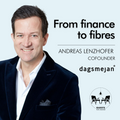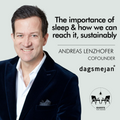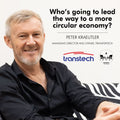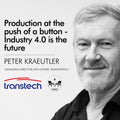Introducing blockchain: Unlocking the power of a data-driven society with Dr. Michael Gebert

Introducing blockchain: Unlocking the power of a data-driven society
GUESTS FOR CHANGE with Dr. Michael Gebert
PART 1
As humans, we are at the frontier of cutting-edge digital technologies - the 4th Industrial Revolution if you will. Things are changing and they’re changing fast. And the world of fashion is among the industries embracing this. Technologies that enable Industry 4.0 and the digitalization of production are already revolutionizing the way things work. Fashion, sitting at the crossroads between the virtual, the creative and the tangible, is in the prime position to take complete advantage of these technological and digital advancements.
One of these new technologies is blockchain. Founded on the principle of decentralization, it speaks to something that we are all feeling across the globe: that developing solutions to problems and creating a better future can only come from working together, trust and collaborating. With an extensive and diverse background, we are honored to have spoken about this with Dr. Michael Gebert, the Chairman of the European Blockchain Association.
With regards to what blockchain technology is, many people probably have heard the term discussed in relation to cryptocurrency - one of the fastest-growing sectors in technology today. Despite this forming a large part of our understanding of blockchain, it is important to be aware that this is not the only application of this kind of technology. Essentially, blockchain is a system of recording information in a way that makes it difficult or impossible to change, hack, or cheat.

Image via natanaelginting
“A blockchain is essentially a digital ledger of transactions that is duplicated and distributed across the entire network of computer systems on the blockchain. Each block in the chain contains a number of transactions, and every time a new transaction occurs on the blockchain, a record of that transaction is added to every participant’s ledger. The decentralized database managed by multiple participants is known as Distributed Ledger Technology (DLT). This means if one block in one chain was changed, it would be immediately apparent it had been tampered with. If hackers wanted to corrupt a blockchain system, they would have to change every block in the chain, across all of the distributed versions of the chain. Blockchains such as Bitcoin and Ethereum are constantly and continually growing as blocks are being added to the chain, which significantly adds to the security of the ledger,” shares Euromoney.com.
“My whole professional life has been driven by innovation,” he shares. “Driven by things that from my understanding can change a lot of things in a positive way. Disrupting things, as we call it.
To Dr. Michael Gebert, blockchain caught his eye when he realized that it could revolutionize so many systems within multiple industries. “My whole professional life has been driven by innovation,” he shares. “Driven by things that from my understanding can change a lot of things in a positive way. Disrupting things, as we call it. And blockchain, per se, has been seen just as a buzzword. But, if you understand the underlying concept and the power of facilitating that concept on a broader scale step-by-step, then I think it deserves digging deeper into. Once you do this, you can have tremendously eye-opening experiences in terms of what could change - whether it is processes, whether it is logistics, if it’s trust, if it is security, you name it. There is the potential of adaptation for a lot of things as long as it is data-driven. And as we are in a data-driven environment and society, literally 99.9% of the things we do on a daily basis is data-driven - and could thereby be enhanced through the use of this technology.”

Image via Getty Images
"With blockchain, you don’t need this trusted third-party anymore, you don’t need the middle-man - because trust is incorporated within the system itself.”
In terms of blockchain specifically, it is already integrated as a major part of our future as humanity. The question then arises as to whether or not it can be a form of technology that can be trusted? “If you look into blockchain, you always have two sides,” shares Dr. Gebert, “Both wanting to interact with each other. It can be humans, it can be things and tools, it can be processes, it can be payments, whatever needs to be connected. However, normally you have a - trusted - facilitator in between. Let’s say you want to transfer money to buy a nice watch, you first transfer the money to that trusted facilitator, for example, a bank, and then the bank, transfers it to the seller as a trusted third-party operator. With blockchain, you don’t need this trusted third-party anymore, you don’t need the middle-man - because trust is incorporated within the system itself.”
When it comes to the real-world application of blockchain technology, Dr. Gebert goes on to share that, “Basically, there are use cases for almost every industry. The beauty of it is that you have an immutable ledger which can tell you where a specific item was and is at the moment.”

Image via Getty Images
“Basically, there are use cases for blockchain use in almost every industry. The beauty of it is that you have an immutable ledger which can tell you where a specific item was and is at the moment.”
“A good example of this is the chemical industries” he continues. “Here you normally have a raw product. Let’s say you want to make sure this raw product can be used on a garment in the fashion industry. There may be special chemicals that make garments more durable or softer, for example. But you want to make sure that the quality that you ship is - on molecule-level - 100% the same quality that is arriving on the other side. For a project in this area, a molecule stamp can be developed. I would say that it’s kind of a blockchain-related QR code that is unique to every chemical that is arriving. Now you just need to check this molecule stamp and see if it’s 100% correct. And the good thing is, you cannot forge it. It has to be 100%. So, if, for example, the chemical would have been exposed to water on the way, the chemical molecule stamp would have changed. And you can see this now. This is one of the things that blockchain can assist with. Because it adds security and trust and also helps to fight corruption. Situations where a document checker says, “It’s not 104g as stated but, I don’t care as long as you give me $100” are just not happening anymore. This is enforcing a lot of trust within a peer-to-peer relationship. So there is, by definition, no trustee needed in the middle.” This takes away margins for human error and opens up doors of transparency.
Being relatively new it will naturally evolve and develop and integrate into society. Read more about how blockchain can be integrated into the textile and fashion industry in the next installment of our conversation with Dr. Michael Gebert.








Leave a comment